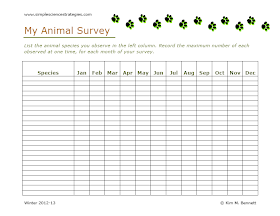Watching Our Birds, All Year Long
We love to watch our birds. With each season, we change our offerings to suit the birds that come with that season: suet for the woodpeckers in the winter; berries and peanuts for the bluebirds in the spring; oranges for the orioles in June; hummingbird nectar for the hummers in July.
It is exciting to see those birds (and other creatures) that signal changes in the seasons. To chronicle the visitors in our yard, we started a year-long animal survey to usher in 2013.
 |
| Our survey sheet -- good for a year of viewing! (c) Kim M. Bennett, 2012 |
We put together an animal survey sheet, where we can list the visitors to our bird feeders, brush pile and water sources, then check off which months we have observed them. To mark shifts in populations, we are entering a number to show the greatest number of each species observed at any given time (similar to what is done to measure relative quantities of birds in Cornell's Project Feeder Watch).
(Click on link to download a copy for your own study.)
The First Week of Our Survey
The first week of January was a busy one. Here is our list of animal visitors (not counting our own pets, of course -- wild animals, only!), in decreasing order of their abundance (NOTE: We noted the maximum number of each animal that was seen at a given time, to monitor the relative abundance of the species for each month): |
| Dark-eyed juncos were our most abundant visitors this week. |
- Dark-eyed junco (7)
- Black-capped chickadee (6)
- Tufted titmouse (4)
- White-tailed deer (4)
- White-throat sparrow (4)
- Blue jay (2)
- Great horned owl (2)
- Mourning dove (2)
- Carolina wren (2)
- Northern cardinal (2)
- Chipping sparrow (2)
- Gray squirrel (2)
- White-breasted nuthatch (1)
- Red-bellied woodpecker (1)
- Downy woodpecker (1)
- Northern flicker (1)
- White-crowned sparrow (1)
Nifty Sightings for the Week
 |
| Click on the link for more information. |
... the junco with leucism -- partial albinism that caused its head and cheek feathers to be completely white, and its sides to be tan in color {my youngest son and I spent a lot of time trying to identify it with our field guides before I found a web article about this form of albinism};
... the great horned owls who perched in the hickory overlooking the feeding area during the night time hours and into the dawn, hooting and hunting {our cats are not happy about being kept in at night the past few weeks};
... the pair of wrens that we watched exploring the inner depths of a folded camp chair on our front porch (you know they'll nest anywhere). {My eldest son and I sat in the car after going to the gym, so we wouldn't disturb the busy pair}
What We Offered Our Feathered and Furry Friends
 |
| Click on the link for more information. |
Read-Alouds to Go With Your Studies
Our two favorite animal books, the Burgess Bird Book for Children and the Burgess Animal Book for Children, are shown here. Click on the links in the captions for more information about these wonderful classics.[This post was linked to the following blog carnivals:]
Outdoor Hour Challenge ~ Winter Bird: Chickadee
Simple Science Strategies: Patterns
A Carnival of Homeschooling
No comments:
Post a Comment